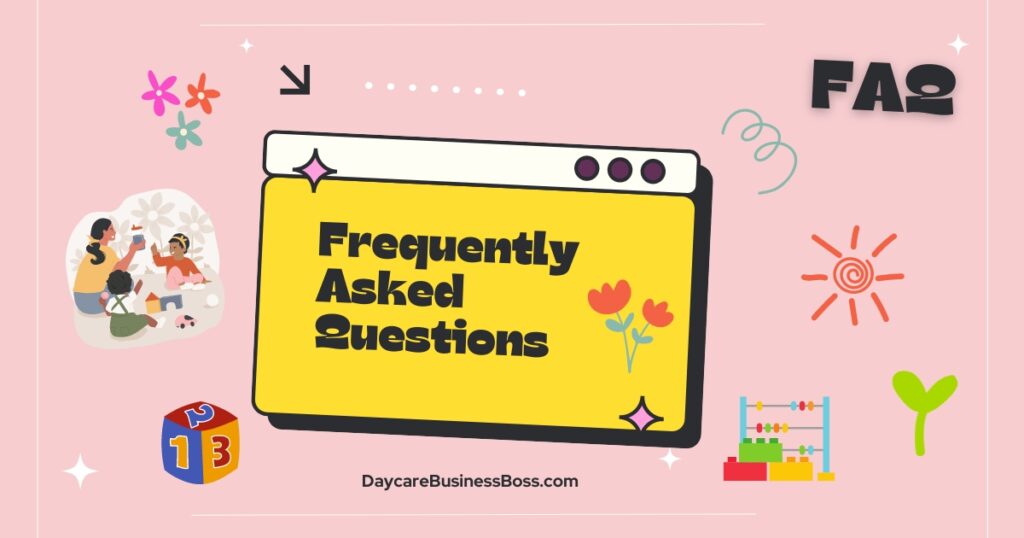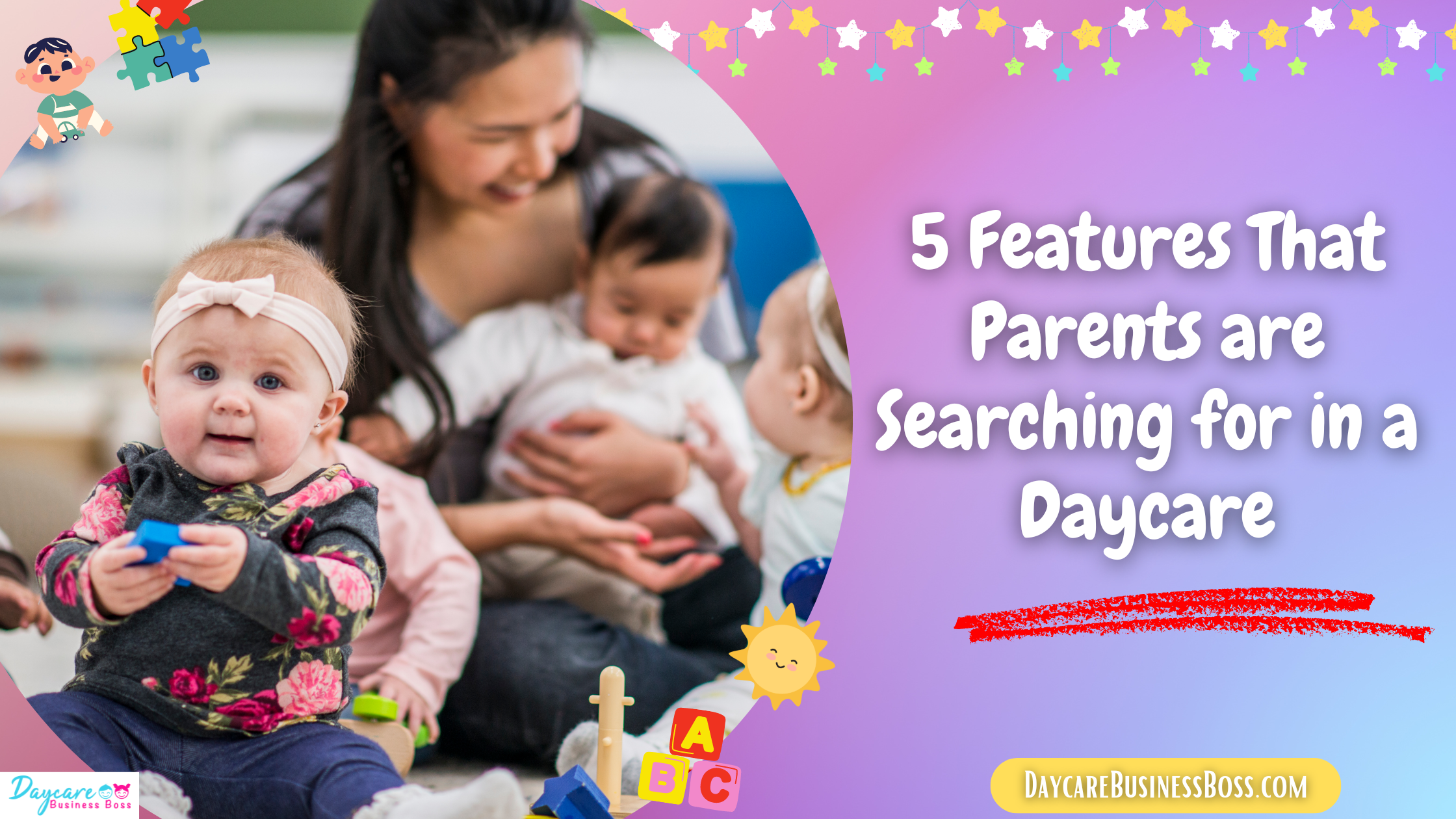You are in the process of opening a child care center in your community. While exciting, there is much to keep in mind to achieve success. You stop and ask yourself, “What are parents actually searching for in a daycare?”.
When parents are looking for a daycare for their children while they go to work for the day, 5 key features will stand out the most to them.
- High-quality staff members.
- Regular communication.
- Smooth operations.
- An age-appropriate curriculum.
- Affordable cost.
Reassure that your daycare has features such as these that stand out to parents so that your facility can maintain high enrollment rates and lower early turnover rates with children unenrolling before they are school age.
1. High-Quality Staff Members
Now while your staff members do not need Master’s degrees or Ph.D.’s to be considered as high-quality staff, they should be:
- Well-trained in daily child care practices.
- Interact well with children in general.
- Maintain patience with children and provide them the proper redirection necessary.
Children are hyperactive, inquisitive, and curious little humans. It’s only natural that they get a little rowdy sometimes. After all, they are still learning about proper human behavior in a public setting when they are attending your daycare facility.
Some of the children’s actions can be upsetting. Aaron hit Abby on the playground. A child is angry about something and breaks crayons or throws chairs because he or she cannot control their temper. No matter how crazy a child’s actions are, staff members must handle any situation in the facility calmly and professionally.
It’s in our human nature to want to yell back and defend our dominance as an adult if a child is screaming at us in defiance. However, screaming back will only make matters worse.
How should my staff handle tough situations in the classroom?
The difference between a staff member and a high-quality staff member is the ability to handle tough situations that may surface at your facility. This means taking an offending child aside (outside of the classroom, if possible) and discussing how he or she is feeling. To calm an irate child, you must:
- Remove the child from the situation that is upsetting him or her.
- Have him or she take a big breath to calm down.
- Ask what happened and get their side of the story.
- Reassure the child that everything is done now and he or she can move on from the incident.
- If another child was involved, eventually bring them both together to exchange an apology.
How do I train my staff members to be well-trained in child care practices?
Training should regularly take place every 1-3 months to maintain that other high-quality feature in staff members.
When a Teacher or Aide participates in the onboarding process, have him or she learn about professional classroom procedures, state mandates about teacher to child ratio, and what to do in the event of a classroom disturbance by a student.
Refer to this checklist regularly to be sure that all of your staff members comprehend and regularly observe these practices even after the onboarding process.
- Your state’s teacher to child ratio is maintained at all times. If you see that the amount of current staff you have cannot accommodate the mandated ratio, hire some Substitute Floating Aides to fill the need.
- How everyone must take part to maintain playground safety during recess.
- Following food allergy policies in the classroom and throughout the facility.
- Every few months, host a training workshop.
- Have scenarios of different classroom disturbances and how to handle them.
- Breaking by an intruder.
- An irate child in the classroom.
- A natural disaster.
- For all staff members (whether they work in the infant classroom or not), give a tutorial on proper infant care.
- Diaper changing.
- Bottle feeding.
- Dressing the child.
- Properly burping a child.
- Sudden Infant Death Syndrome (SIDS) and preventative measures.
- Any other checkpoints you feel are important to cover.
- Have scenarios of different classroom disturbances and how to handle them.
2. Regular Communication
Regular communication will put parents at ease while their children attend your facility. Especially if it’s a first-time parent enrolling their child into daycare, it can be a rough transition from having the child at home to having him or them regularly at daycare to hold a workforce position.
A popular classroom communication app is Class Dojo. On this app, you can communicate with parents via text messaging for quick updates on their child’s day. Parents can receive pictures along with these texts. Having your teachers send pictures to parents will reinforce trust between the facility and the children’s parents and guardians.
Can parents and teachers communicate beyond daycare hours?
Even communication outside of regular daycare hours (upon the teacher’s discretion) could harvest a strong relationship between the teacher and the parent. If a child is sick, the parent can send updates to the teacher on how the child is doing and give an estimated date of return to the facility.
Parents can even send pictures of educational and interactive activities they are doing with the child to receive input from the teacher on what can be done better to make it more worthwhile.
3. Smooth Operations

When parents visit your daycare for a tour, they will be looking for your teachers and aides’ ability to maintain smooth operations in the classroom. This means:
- Following a regular schedule throughout the day.
- Able to properly and calmly redirect children that are currently going off task.
- Finding a listening mechanism to get a rowdy classroom to listen to the teachers and aides.
- “1, 2, 3, all eyes on me!”
How should my classrooms maintain a regular schedule?
Each classroom should have a posted schedule showing the time frames for each activity. Every schedule should be age-appropriate to accommodate their special developmental and physical needs.
Toddler classrooms for children ages 1-3 usually have breakfast, circle time, music and movement, craft time, center time, lunch, and a 2-hour nap in the first half of the day. The second half of the day consists of snacks and more free center time and/or recess time outside (weather permitting).
Infant classrooms may follow this same schedule. However, they may allow for an extended nap, since they are younger and usually nap more in the middle of the day.
For children ages 4-5, you can add more educational subjects into the mix and knock out the nap entirely. Have them learn the pledge of allegiance and make some time to learn basic mathematics, reading, phonics, and spelling, so they have an early start before kindergarten.
4. An Age-Appropriate Curriculum
Write an age-appropriate curriculum for infants, toddlers, and preschoolers at your daycare. Incorporate the right amount of learning by play along with academic pursuits in mathematics, language, science, and art.
Incorporating crafts into these academic pursuits will make it fun and memorable for toddlers and preschoolers. Here are some examples.
- Shapes Pizza (Math): Make a pizza using a paper plate and construction paper cut-outs of triangles, circles, and squares. Have the child paste as many of each shape as he or she wants. After the activity, have each child count how many of each shape is on their Shapes Pizza.
- Beads on a Bracelet (Math and Phonics): Have the toddlers and preschoolers make bracelets. Teach them that “bead” and “bracelet” start with the letter B. Sprinkle in a math concept by having them count all the beads on their bracelet before finalizing it into a wearable piece of jewelry.
Look for more information on how to create an age-appropriate curriculum at Hi Momma.
5. Affordable Cost
The cost of daycare per month is becoming as much-if not more-as one month’s rent for most Americans. Google your state’s average daycare cost, and you will see what we are talking about.
You want to be sure that your costs are fair to help your facility, but more importantly, it should be low enough that it is affordable for parents as well. For low-income parents, there are state child care subsidies that the parent can receive to make child care more affordable for them. This is beneficial for them to still be able to pay all their bills without having to choose between working a job outside the home or staying home to care for their child.
Daycares usually charge a couple hundred per week for child care based on the age group in which your child is affiliated. Research the daycares around you to see their weekly rates for each age group. Try to have your rates $20 or so lower than the average weekly rate in your area. Be sure it is still reasonable for you, so your facility will not fall under.
Conclusion
Continually train your staff, maintain regular communication, and operate your daycare classrooms smoothly to attract more parents to enroll at your facility. Writing an age-appropriate curriculum and keeping costs affordable will also put parents at ease about attending your facility. Help the children to learn something every day without breaking the parents’ pockets.
What other key features that your daycare is doing that are not shown on this list? Spark a conversation and talk about it in the comments.
Happy teaching, daycare owners!
Check out how much you should charge HERE!
Related Questions

What engaging curriculum-based events can I host at my daycare?
Try these engaging curriculum-based events at your daycare:
- Scholastic book fairs.
- Seasonal events
- Create a gingerbread house for the holidays. Have children count out each type of candy they are using when placing it on the edible house.
- Painting flowers for spring. Have a refresher lesson about colors.
- Mock beach day during the summer. Build sandcastles, play with a water table, etc.
What other listening mechanisms can I use in the classroom to calm rowdy students?
Besides “1, 2, 3, all eyes on me”, try these other listening mechanisms to calm a classroom:
- Play Simon says with the kids. Something like “Simon says, no more talking” and follow up with “Simon says, look up at me”.
Call for “(insert teacher’s name) class” instead of “Boys and girls” for the children to be more attentive to you as the teacher.
Please note: This blog post is for educational purposes only and does not constitute legal advice. Please consult a legal expert to address your specific needs.
To learn more on how to start your own daycare checkout my startup course and documents here.

Meet Shawn Chun: Entrepreneur and Childcare Business Fan.
I’m a happy individual who happens to be an entrepreneur. I have owned several types of businesses in my life from a coffee shop to an import and export business to an online review business plus a few more and now I create online daycare business resources for those interested in starting new ventures. It’s demanding work but I love it. I do it for those passionate about their business and their goals. That’s why when I meet a childcare business owner, I see myself. I know how hard the struggle is to retain clients, find good employees and keep the business growing all while trying to stay competitive.
That’s why I created Daycare Business Boss: I want to help childcare business owners like you build a thriving business that brings you endless joy and supports your ideal lifestyle.


1 thought on “5 Features That Parents Are Searching for in a Daycare”
Comments are closed.